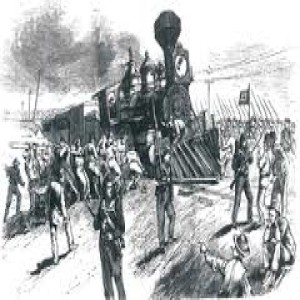
On this day in labor history, the year was 1877.
That was the day that some of the worst violence of the Great Railroad Strike erupted in Pittsburgh.
The strike started days earlier. It is contested as to whether it began in Martinsburg, West Virginia or Baltimore.
The strike spread rapidly along the Baltimore & Ohio Railroad to New York State, Pennsylvania and throughout the Midwest.
At its height, the Great Railroad Strike involved well over 100,000 workers.
The strike began on the Pennsylvania Railroad on the 19th.
Management repeatedly tried to move trains through the yards and was confronted by angry strikers. Pennsylvania Guardsmen were called out.
The strikers presented the railroad with their demands: they wanted an end to double engine trains that required fewer workers, wages reinstated, reinstatement for their fired coworkers and an end to pay grades.
Local militia sided with the strikers and refused to show for duty.
When thousands of strikers gathered at the depot, the Pennsylvania National Guard moved unsuccessfully to disperse them.
Then they fired on strikers, killing 20 and wounding 29.
The strikers were infuriated by the deadly aggression and drove guardsmen into a nearby railroad roundhouse.
Word spread quickly throughout the city of the massacre, launching a virtual general strike. Workers began seizing arms wherever they could find them.
They set fires to dozens of railroad buildings, burned down the Union Depot, destroyed over 100 locomotives and more than 1000 freight and passenger cars.
The next day, guardsmen shot their way out of the roundhouse, killing 20 more as they were chased from the city.
A total of 3000 federal troops would be necessary to quell strikers’ fury by month’s end.
More Episodes
 2024-10-21
2024-10-21
 2024-10-18
2024-10-18
 2024-10-17
2024-10-17
 2024-10-16
2024-10-16
 2024-10-15
2024-10-15
 2024-10-14
2024-10-14
 2024-10-14
2024-10-14
 2024-10-10
2024-10-10
 2024-10-09
2024-10-09
 2024-10-08
2024-10-08
 2024-10-07
2024-10-07
 2024-10-06
2024-10-06
 2024-10-06
2024-10-06
Create your
podcast in
minutes
- Full-featured podcast site
- Unlimited storage and bandwidth
- Comprehensive podcast stats
- Distribute to Apple Podcasts, Spotify, and more
- Make money with your podcast
It is Free
- Privacy Policy
- Cookie Policy
- Terms of Use
- Consent Preferences
- Copyright © 2015-2024 Podbean.com




